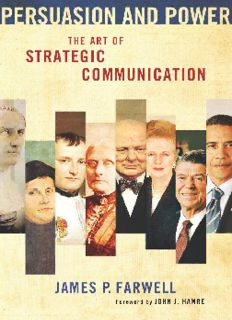
Persuasion and Power: The Art of Strategic Communication PDF
Preview Persuasion and Power: The Art of Strategic Communication
Persuasion and Power This page intentionally left blank Persuasion and Power The art of strategic Communication James P. Farwell Georgetown University Press Washington, DC © 2012 Georgetown University Press. All rights reserved. No part of this book may be reproduced or utilized in any form or by any means, electronic or me- chanical, including photocopying and recording, or by any information storage and retrieval system, without permission in writing from the publisher. Library of Congress Cataloging-in-Publication Data Farwell, James P. Persuasion and power : the art of strategic communication / by James P. Farwell ; foreword by John J. Hamre. p. cm. Includes bibliographical references and index. ISBN 978-1-58901-942-3 (pbk. : alk. paper) 1. Communication in politics. 2. Communication in international relations. I. Title. JA85.F37 2012 320.01'4—dc23 2012007819 ƒ This book is printed on acid-free paper meeting the requirements of the American National Standard for Permanence in Paper for Printed Library Materials. 15 14 13 12 9 8 7 6 5 4 3 2 First printing This is dedicated to four exceptional colonels from whose wisdom I have learned much: Colonel Al Bynum, USAF (Ret) Colonel Paul Huxhold, USMC (Ret) Colonel Stephen Padgett, OBE, British Army Colonel Sandy Wade, OBE, British Army This page intentionally left blank Contents Foreword by John J. Hamre ix Acknowledgments xi List of Abbreviations xiii Introduction xv Part i: The Forms of Strategic Communication 1 1: Psychological Operations 3 2: Propaganda: The Resonance of Emotion 23 3: Public Affairs: Concept versus Reality 37 4: Public Diplomacy 47 Part ii: Words, Images and Symbols, and Deeds 55 5: Words 57 6: Images and Symbols 79 7: Deeds 93 Part iii: Campaigns of Influence 105 8: Do Authoritarians Care? 107 9: Is Success about Leadership or Communication? 115 10: The Marks of Leadership 137 11: Campaigns of Influence 143 12: Defining Winning or Losing 149 13: Strategy 153 14: Tactics 175 viii Contents Part iV: Weapons of Strategic Communication 181 15: Television as a Weapon 183 16: Radio as a Weapon 201 Part V: More Effective Strategic Communication 211 17: Change That Would Matter 213 18: Conclusion 227 Notes 229 About the Author 271 Index 273 Foreword The late Senator Russell Long once told a story, making fun of his own ex- perience. It seems that two different cities in Louisiana were competing for a federal project. A delegation from each city contacted his office asking for his special help to sway the process in their favor. Senator Long’s scheduling secretary became confused, not realizing there were competing delegations. She arranged for both city delegations to meet with Senator Long at precisely the same time. Senator Long walked into the meeting, and, realizing the peril in the situation, drew upon his vast reservoir of humor: “Look here, friends. If you want me to agree with you, you are going to have to come in here separately.” This rather simple story contains vast wisdom for our age. We live in a time when it is no longer possible to take two different positions to a problem, thinking they will never be exposed to reconciliation over time. There was per- haps a time when differing messages could be offered to different audiences to no ill effect. This is no longer the case. In an era of global and near-instanta- neous communications, there is no practical way to segment different themes to one’s motives or actions. Democratic governments have an inherent problem: they need to under- take some activities of state in secrecy. But democracies ultimately have to take all matters to the public for open debate. Private, secret actions may represent an initiative of an administration, but they do not represent a commitment of the nation until they are forged through public debate into a national con- sensus. The so-called WikiLeak controversy in 2010 was illuminating. Tens of thousands of secret cables were suddenly released to newspapers for pub- lic display. Importantly, there were no disconnects between secret policy and public debate. Certainly, there were important details in the secret cables, and sometimes salacious details that would be embarrassing when exposed to the public. But there was no fundamental disconnect in our secret diplomacy and our public debate about national intents and purposes. The WikiLeaks inci- dent demonstrated a fundamental integrity in American democracy, where our secret diplomacy was fully faithful to our democracy.
Description: